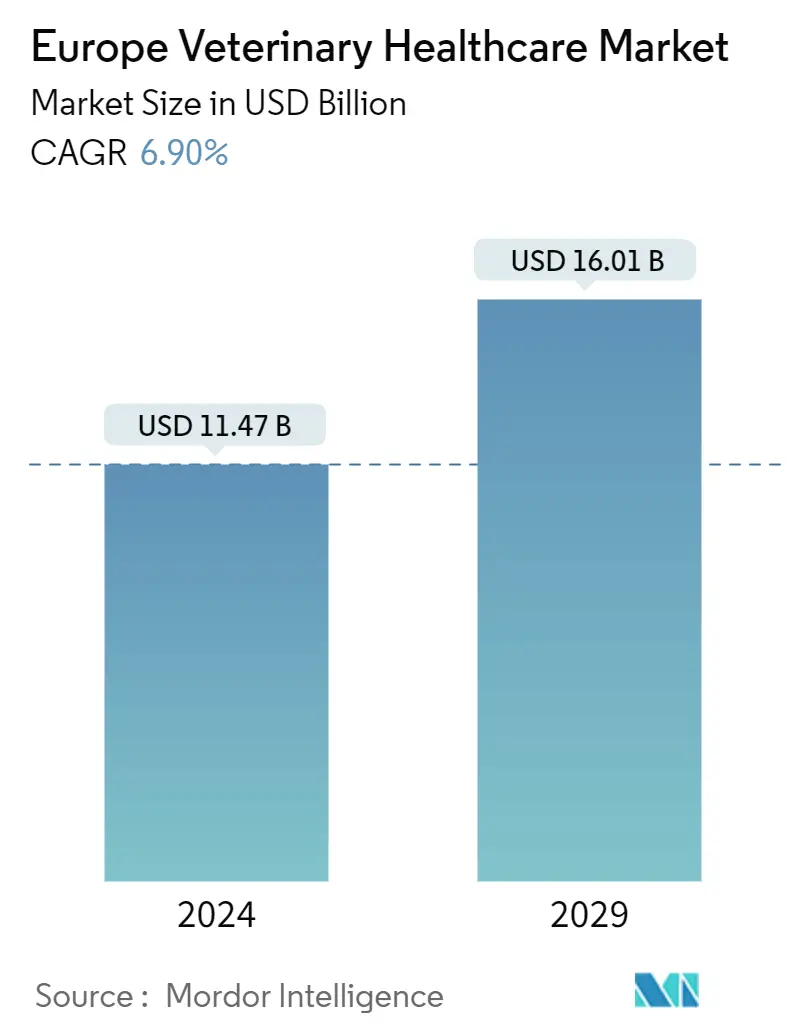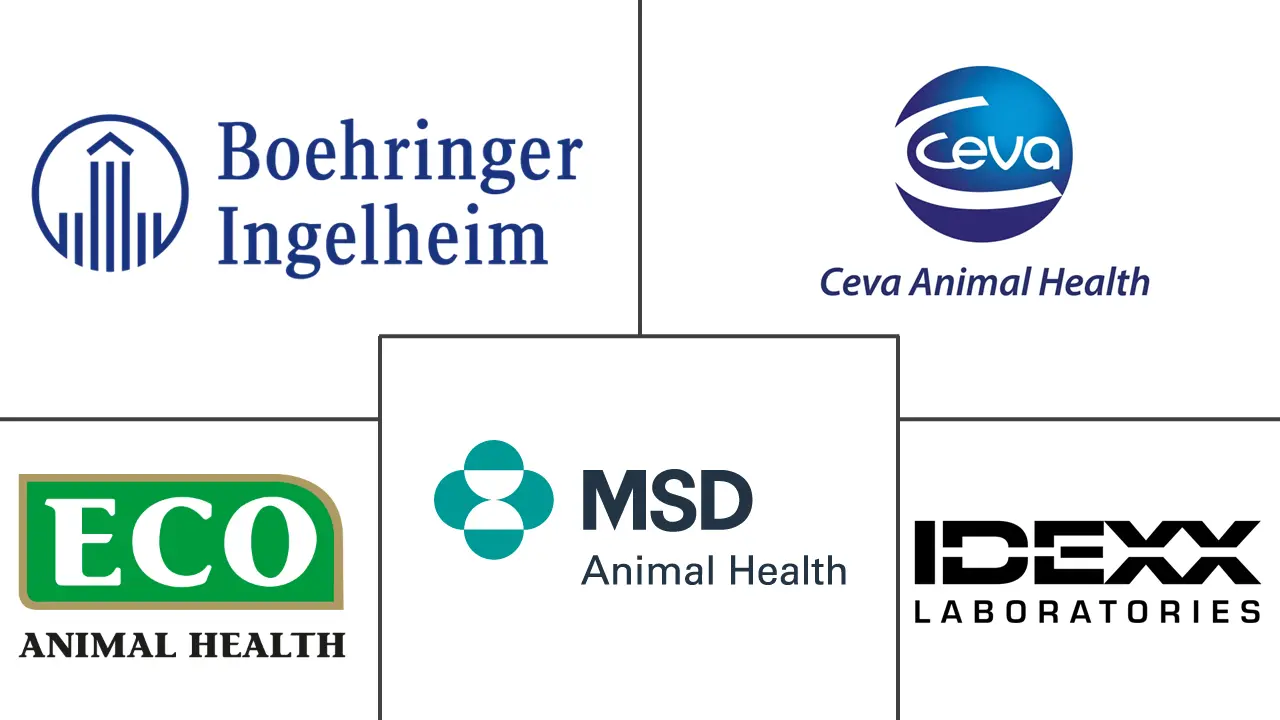Market Size of Europe Veterinary Healthcare Industry

| Study Period | 2021 - 2029 |
| Base Year For Estimation | 2023 |
| Forecast Data Period | 2024 - 2029 |
| Market Size (2024) | USD 11.47 Billion |
| Market Size (2029) | USD 16.01 Billion |
| CAGR (2024 - 2029) | 6.90 % |
Major Players
*Disclaimer: Major Players sorted in no particular order |
Europe Veterinary Healthcare Market Analysis
The Europe Veterinary Healthcare Market size is estimated at USD 11.47 billion in 2024, and is expected to reach USD 16.01 billion by 2029, growing at a CAGR of 6.90% during the forecast period (2024-2029).
The major factors driving the market's growth include the rise in pet adoptions, increasing initiatives by governments and animal welfare associations, and technological advancements in the Europe Animal Healthcare Market.
In recent years, pet owners have increasingly adopted animals influenced by their interests and concerns, leading to higher demands for veterinary healthcare products in Europe, including diagnostic imaging and treatment to ensure the health and well-being of these animals. This rising pet population, coupled with changes in lifestyle patterns, increased the adoption of diagnostic imaging and Veterinary Medicine products for animals, boosting the growth of the veterinary healthcare market in Europe.
For instance, according to data updated by the European Pet Food Industry Federation (FEDIAF), Report 2023, the dog population in the region was over 66.8 million, while the cat population was over 77.9 million in Europe in 2023. According to the same source, in Poland, in 2023, over 49% of the households owned at least one dog, and over 40% owned a cat. The Global State of Pet Care report published by the HealthForAnimals Organization in September 2022 highlighted that over half a billion dogs and cats were adopted by families in Europe, along with the United States, Brazil, and China. The high pet ownership rates in Europe are driving the growth of the veterinary healthcare market by increasing the demand for Pet Healthcare therapeutics and products.
Moreover, major players in the market are working on introducing novel product launches to cater to the rising demand for Veterinary Products in the region. For instance, in April 2023, Bioberica launched its Atopivet Collar, contributing to the growing Veterinary Collars Market, as one of the first alternatives to traditional topical and oral treatments for skin diseases in Spain. The collar releases its biologically derived skin health ingredients directly onto the pet's skin, which is then spread across the body through the skin's lipids.
In conclusion, the factors mentioned above, such as the rising pet population and technological advancements by key players in the market, are expected to propel the European veterinary healthcare market's growth during the forecast period. However, counterfeit medicines and the increasing cost of animal testing and Veterinary Therapeutics are expected to hinder the market's growth during the study period.
Europe Veterinary Healthcare Industry Segmentation
As per the report's scope, veterinary healthcare can be defined as the science associated with diagnosing, treating, and preventing animal diseases. The increasing importance of the production of livestock animals is generating growth in the veterinary healthcare market. The European veterinary healthcare market is segmented by product, animal type, and geography. The product segment is further segmented into therapeutics and diagnostics. The therapeutics segment is further segmented into vaccines, parasiticides, anti-infectives, medical feed additives, and other therapeutics, while the diagnostic segment is divided into immunodiagnostic tests, molecular diagnostics, diagnostic imaging, clinical chemistry, and other diagnostics. The animal type segment is further divided into dogs and cats, horses, ruminants, swine, poultry, and other animals. The geography segment is further divided into Germany, the United Kingdom, France, Italy, Spain, and the Rest of Europe. The report offers the value (USD) for the above segments.
| By Product | |||||||
| |||||||
|
| By Animal Type | |
| Dogs and Cats | |
| Horses | |
| Ruminants | |
| Swine | |
| Poultry | |
| Other Animals |
| By Geography | |
| Germany | |
| United Kingdom | |
| France | |
| Italy | |
| Spain | |
| Rest of Europe |
Europe Veterinary Healthcare Market Size Summary
The European veterinary healthcare market is experiencing significant growth, driven by an increase in pet ownership and advancements in animal healthcare technology. The rising number of pets, particularly dogs and cats, has led to a higher demand for veterinary healthcare products and services, including diagnostics and treatments. This trend is further supported by initiatives from governments and animal welfare organizations, which are promoting pet health and well-being. The market is characterized by the introduction of innovative products, such as Bioberica's Atopivet Collar, which offers alternative treatments for skin diseases. However, challenges such as counterfeit medicines and the high cost of animal testing may impede market growth.
In the UK, the veterinary healthcare market is also poised for robust expansion, fueled by increased awareness of animal diseases and a growing emphasis on pet health. The prevalence of conditions like osteoarthritis among pets is driving demand for veterinary care, supported by government initiatives to enhance animal health. The market is moderately competitive, with major players like Boehringer Ingelheim and MSD Animal Health leading the way through product launches and strategic partnerships. Recent developments, such as the introduction of the Nu.Q Vet Cancer Test, highlight the ongoing innovation in veterinary diagnostics. Overall, the European veterinary healthcare market is set to grow, driven by technological advancements, rising pet ownership, and supportive regulatory frameworks.
Europe Veterinary Healthcare Market Size - Table of Contents
-
1. MARKET DYNAMICS
-
1.1 Market Overview
-
1.2 Market Drivers
-
1.2.1 Rising number of Pet Adoptions
-
1.2.2 Increasing Initiatives by Governments and Animal Welfare Associations
-
1.2.3 Technological Advancements in Animal Healthcare
-
-
1.3 Market Restraints
-
1.3.1 Use of Counterfeit Medicines
-
1.3.2 Increasing Pet Care Costs
-
-
1.4 Porter's Five Forces Analysis
-
1.4.1 Threat of New Entrants
-
1.4.2 Bargaining Power of Buyers/Consumers
-
1.4.3 Bargaining Power of Suppliers
-
1.4.4 Threat of Substitute Products
-
1.4.5 Intensity of Competitive Rivalry
-
-
-
2. MARKET SEGMENTATION (Market Size by Value - USD million)
-
2.1 By Product
-
2.1.1 Therapeutics
-
2.1.1.1 Vaccines
-
2.1.1.2 Parasiticides
-
2.1.1.3 Anti-infectives
-
2.1.1.4 Medical Feed Additives
-
2.1.1.5 Other Therapeutics
-
-
2.1.2 Diagnostics
-
2.1.2.1 Immunodiagnostic Tests
-
2.1.2.2 Molecular Diagnostics
-
2.1.2.3 Diagnostic Imaging
-
2.1.2.4 Clinical Chemistry
-
2.1.2.5 Other Diagnostics
-
-
-
2.2 By Animal Type
-
2.2.1 Dogs and Cats
-
2.2.2 Horses
-
2.2.3 Ruminants
-
2.2.4 Swine
-
2.2.5 Poultry
-
2.2.6 Other Animals
-
-
2.3 By Geography
-
2.3.1 Germany
-
2.3.2 United Kingdom
-
2.3.3 France
-
2.3.4 Italy
-
2.3.5 Spain
-
2.3.6 Rest of Europe
-
-
Europe Veterinary Healthcare Market Size FAQs
How big is the Europe Veterinary Healthcare Market?
The Europe Veterinary Healthcare Market size is expected to reach USD 11.47 billion in 2024 and grow at a CAGR of 6.90% to reach USD 16.01 billion by 2029.
What is the current Europe Veterinary Healthcare Market size?
In 2024, the Europe Veterinary Healthcare Market size is expected to reach USD 11.47 billion.

